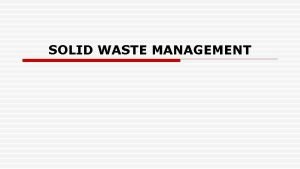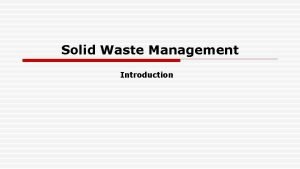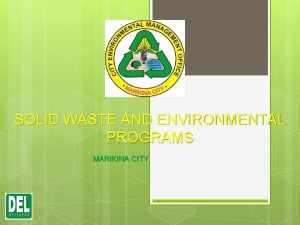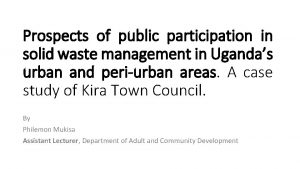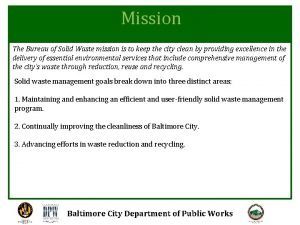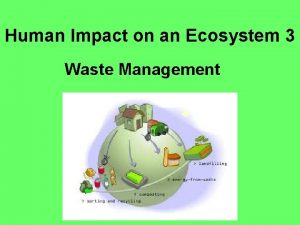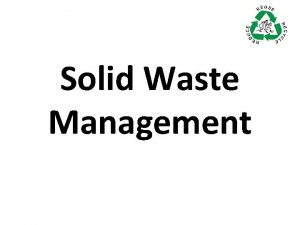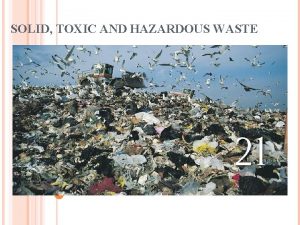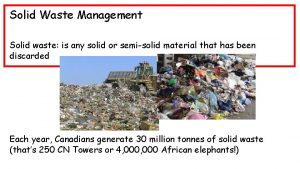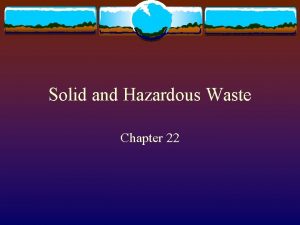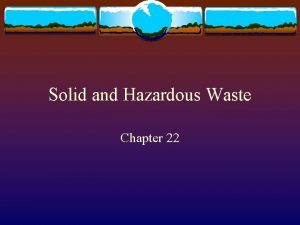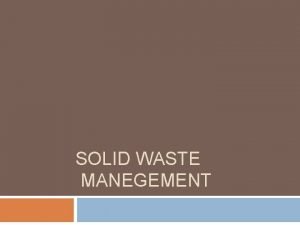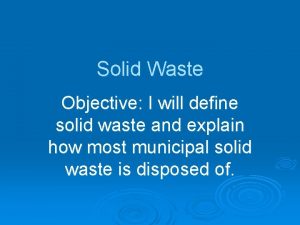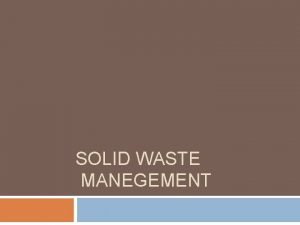Chapter 19 Waste Section 1 Solid Waste The

















- Slides: 17

Chapter 19: Waste Section 1: Solid Waste

The Generation of Waste Every year, the US generates more than 10 billion metric tons of solid waste. (has doubled since the 1960 s) 10, 000, 000 dictionaries Solid Waste: any discarded solid material. Includes: everything from junk mail to coffee grounds to cars.

Space and Waste Many towns are running out of space to dispose of waste people create. Example: barge 1987 from Islip, NY http: //www. nytimes. com/video/b ooming/100000002206073/voya ge-of-the-mobro-4000. html

Population and Waste Earth’s human population and amount of waste we produce is growing. Amount of land available person is shrinking. Hunter Gatherers vs. People Today…what kind of waste was created then?

Not All Wastes Are Equal Problems are caused by amount of solid waste and type of waste. Biodegradable: can be broken down by biological processes (paper, cotton fibers, leather) Nonbiodegradable: cannot be broken down by biological processes (polyester, nylon, plastic)

Plastic Problems Made from petroleum and natural gas. Molecular chains not found in nature. Cannot be broken down by natural processes.

Types of Solid Waste Municipal Waste: what we throw out on a day-to-day basis. Manufacturing Waste: computers, audio equipment, printers Mining Waste: waste rock, minerals, topsoil

Municipal Solid Waste 2% of total solid waste Would fill a convoy of garbage trucks that would stretch around the Earth about 6 times! Amount of MSW grows faster than mining or agricultural waste.

Solid Waste from Manufacturing, Mining, and Agriculture Manufacturing waste: scrap metal, plastics, paper, sludge, ash. Mining: rock and minerals left over from excavating. Left, dumped in oceans, or used to refill mines. Agricultural: biodegradable, but fertilizers and pesticides make it hard to dispose of.

Solid Waste Management Most municipal waste in US is sent to landfill. Some waste is incinerated. Some waste is recycled (28% presently vs. 6. 6% in 1970. )

Landfill More than 50% of municipal and manufacturing solid wasted ends up in landfills. Landfill: permanent wastedisposal facility where wastes are put in the ground and covered with soil or plastic.


Problems with Landfills Leachate: liquid that has passed through compacted solid waste in a landfill and contains chemicals. Methane: produced by organic waste decomposing where there is no oxygen. (highly flammable)

Safeguarding Landfills Must be lined with clay and plastic liners Must have systems for collecting and treating leachate.

Building More Landfills The EPA estimates that the active landfills in 20 states will be filled to capacity within 10 years.

Incinerators Incinerated materials can take up less space, but they can also produce toxic gases. Incinerators must have special air pollution control devices which do not remove all toxins.

 Amorphous vs crystalline
Amorphous vs crystalline Example of solution
Example of solution Covalent molecular and covalent network
Covalent molecular and covalent network Lattice basis
Lattice basis Crystalline solid
Crystalline solid Crystalline solid and amorphous solid
Crystalline solid and amorphous solid Law of constancy of interfacial angle
Law of constancy of interfacial angle When a solid completely penetrates another solid
When a solid completely penetrates another solid Interpenetration of solids
Interpenetration of solids Evaporating mixtures
Evaporating mixtures Principles of waste management
Principles of waste management Solid
Solid Solid waste management meaning
Solid waste management meaning Marikina garbage collection schedule 2020
Marikina garbage collection schedule 2020 Solid waste disposal introduction
Solid waste disposal introduction Conclusion of solid waste management
Conclusion of solid waste management 3 waste disposal
3 waste disposal Types of transfer stations in solid waste management
Types of transfer stations in solid waste management










